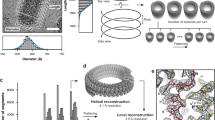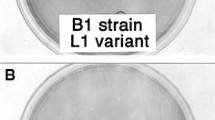Summary
Baby hamster kidney cell monolayers were infected with unfractionated vesicular stomatitis virus at input multiplicities ranging from 1 to 1/105. Cells infected at multiplicities of 1/103 or less produced 10 times as much infective virus but considerably less interfering component than cells infected at multiplicities exceeding 1/100. This has been shown to be due to the presence in the unfractionated virus pool of 2 viruses having different growth rates. The faster growing virus (lag phase 2 hours) does not cause interference, even at multiplicities greater than 100, and does not produce measurable amounts of interfering component in a single passage. The slower growing virus has a lag phase of 3.5 hours and produces large quantities of interfering component in addition to infective virus. This virus will also interfere with viral replication when 10 to 50 particles are added to each cell. A similar number of interfering particles are required to produce the same amount of inhibition. The interfering particle is not self-replicating but is produced only when virus multiplies. The simultaneous presence of infective and interfering particles in a virus harvest is explained by the earlier formation and release of infective virus in the growth cycle.
Similar content being viewed by others
References
Bradish, C. J., J. B. Brooksby, andJ. F. Dillon, Jun.: Biophysical studies of the virus system of vesicular stomatitis. J. gen. Microbiol.14, 290 (1956).
Brown, F., B. Cartwright, andJ. D. Almeida: The antigens of vesicular stomatitis virus. I. Separation and immunogenicity of three complement-fixing components. J. Immunol.96, 537 (1966).
Brown, F., S. J. Maktin, B. Cartwright, andJoan Crick: The ribonucleic acids of the infective and interfering components of vesicular stomatitis virus. J. gen. Virol.1, 479 (1967).
Cooper, P. D., andA. J. D. Bellett: A transmissible interfering component of vesicular stomatitis virus preparations. J. gen. Microbiol.21, 485 (1959).
Crick, Joan, B. Cartwright, andF. Brown: Interfering components of vesicular stomatitis virus. Nature (Lond.)211, 1204 (1966).
Hackett, A. J.: A possible morphological basis for the autointerference phenomenon in vesicular stomatitis virus. Virology24, 51 (1964).
Hackett, A. J., F. L. Schaffer, andS. H. Madin: The separation of infectious and autointerfering particles in vesicular stomatitis virus preparations. Virology31, 114 (1967).
Howatson, A. F., andG. F. Whitmore: The development and structure of vesicular stomatitis virus. Virology16, 466 (1962).
Huang, A. S., J. W. Greenawalt, andR. R. Wagner: Defective T particles of vesicular stomatitis virus. I. Preparation, morphology and some biologic properties. Virology30, 161 (1966).
Huang, A. S., andR. R. Wagner: Defective T particles of vesicular stomatitis virus. II. Biologic role in homologous interference. Virology30, 173 (1966).
Macpherson, I., andM. Stoker: Polyoma transformation of hamster cell clones — an investigation of genetic factors affecting cell competence. Virology16, 147 (1962).
Reczko, Eva: Elektronenmikroskopische Untersuchungen am Virus der Stomatitis Vesicularis. Arch. ges. Virusforsch.10, 588 (1960).
Reed, L. J., andH. Muench: A simple method of estimating fifty per cent endpoints. Amer. J. Hyg.27, 493 (1938).
Schaffer, F. L., andL. H. Frommhagen: Similarities of biophysical properties of several human enteroviruses as shown by density gradient centrifugation of mixtures of the viruses. Virology25, 662 (1965).
Author information
Authors and Affiliations
Rights and permissions
About this article
Cite this article
Crick, J., Cartwright, B. & Brown, F. A study of the interference phenomenon in vesicular stomatitis virus replication. Archiv f Virusforschung 27, 221–235 (1969). https://doi.org/10.1007/BF01249645
Received:
Issue Date:
DOI: https://doi.org/10.1007/BF01249645




